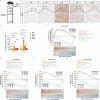Stage-specific requirement for METTL3-dependent m6A epitranscriptomic regulation during myogenesis
- PMID: 40885842
- PMCID: PMC12398539
- DOI: 10.1038/s42003-025-08759-5
Stage-specific requirement for METTL3-dependent m6A epitranscriptomic regulation during myogenesis
Abstract
The regulatory role of N6-methyladenosine (m6A) modification in skeletal muscle myogenesis and muscle homeostasis remains poorly characterized, particularly regarding the functional significance of methyltransferase-like 3 (METTL3), the catalytic subunit of the m6A methyltransferase complex (MTC), in myogenic regulation. Through systematic investigation of m6A epitranscriptomic remodeling during myogenesis, we demonstrate that METTL3-mediated m6As orchestrates myoblast fusion processes in both differentiation and regeneration contexts. Notably, we observed marked induction of Mettl3 expression post-injury, accompanied by substantial transcriptomic alterations in myogenesis-related pathways. High-resolution m6A mapping revealed distinct dynamic patterns of METTL3-regulated m6As during differentiation, exhibiting dichotomous regulation across target transcripts. Mechanistically, we identified myogenic fusion factors Mymx and Mymk as direct targets of METTL3, showing concomitant upregulation of both transcript abundance and m6A deposition during myogenesis. This study provides comprehensive multi-omics resources delineating the mechanistic landscape of METTL3-regulated m6As in myogenic programming, establishing METTL3 as a critical regulatory node governing myoblast fusion dynamic.
© 2025. The Author(s).
Conflict of interest statement
Competing interests: The authors declare no competing interests.
Figures








Similar articles
-
METTL3-dependent m6A modification of GHR mRNA regulates mitochondrial function through mitochondrial biogenesis during myoblast differentiation.Poult Sci. 2025 Jul;104(7):105216. doi: 10.1016/j.psj.2025.105216. Epub 2025 Apr 25. Poult Sci. 2025. PMID: 40344709 Free PMC article.
-
The m6A reader IGF2BP3 facilitates myogenesis by activating the CAMK2B-MEF2C axis.Int J Biol Macromol. 2025 Aug;320(Pt 4):146123. doi: 10.1016/j.ijbiomac.2025.146123. Epub 2025 Jul 17. Int J Biol Macromol. 2025. PMID: 40683492
-
METTL3 regulates PRRSV replication by suppressing interferon beta through autophagy-mediated IKKε degradation.J Virol. 2025 Jul 22;99(7):e0009825. doi: 10.1128/jvi.00098-25. Epub 2025 Jun 23. J Virol. 2025. PMID: 40548751 Free PMC article.
-
The critical role of METTL3-mediated m6A RNA methylation in orchestrating musculoskeletal development: Underlying mechanisms and therapeutic perspectives.Tissue Cell. 2025 Aug 22;97:103098. doi: 10.1016/j.tice.2025.103098. Online ahead of print. Tissue Cell. 2025. PMID: 40848415 Review.
-
METTL3-driven m6A modifications in esophageal squamous cell Carcinoma: Emerging mechanisms, biomarker potential, and therapeutic innovations.Eur J Pharmacol. 2025 Sep 5;1002:177785. doi: 10.1016/j.ejphar.2025.177785. Epub 2025 May 29. Eur J Pharmacol. 2025. PMID: 40449646 Review.
References
MeSH terms
Substances
Grants and funding
LinkOut - more resources
Full Text Sources
Research Materials

